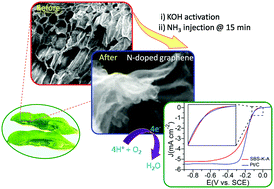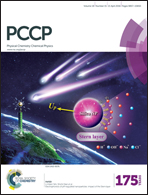Transforming waste biomass with an intrinsically porous network structure into porous nitrogen-doped graphene for highly efficient oxygen reduction†
Abstract
Porous nitrogen-doped graphene with a very high surface area (1152 m2 g−1) is synthesized by a novel strategy using intrinsically porous biomass (soybean shells) as a carbon and nitrogen source via calcination and KOH activation. To redouble the oxygen reduction reaction (ORR) activity by tuning the doped-nitrogen content and type, ammonia (NH3) is injected during thermal treatment. Interestingly, this biomass-derived graphene catalyst exhibits the unique properties of mesoporosity and high pyridine-nitrogen content, which contribute to the excellent oxygen reduction performance. As a result, the onset and half-wave potentials of the new metal-free non-platinum catalyst reach −0.009 V and −0.202 V (vs. SCE), respectively, which is very close to the catalytic activity of the commercial Pt/C catalyst in alkaline media. Moreover, our catalyst has a higher ORR stability and stronger CO and CH3OH tolerance than Pt/C in alkaline media. Importantly, in acidic media, the catalyst also exhibits good ORR performance and higher ORR stability compared to Pt/C.


 Please wait while we load your content...
Please wait while we load your content...